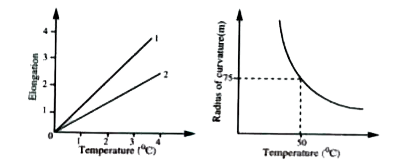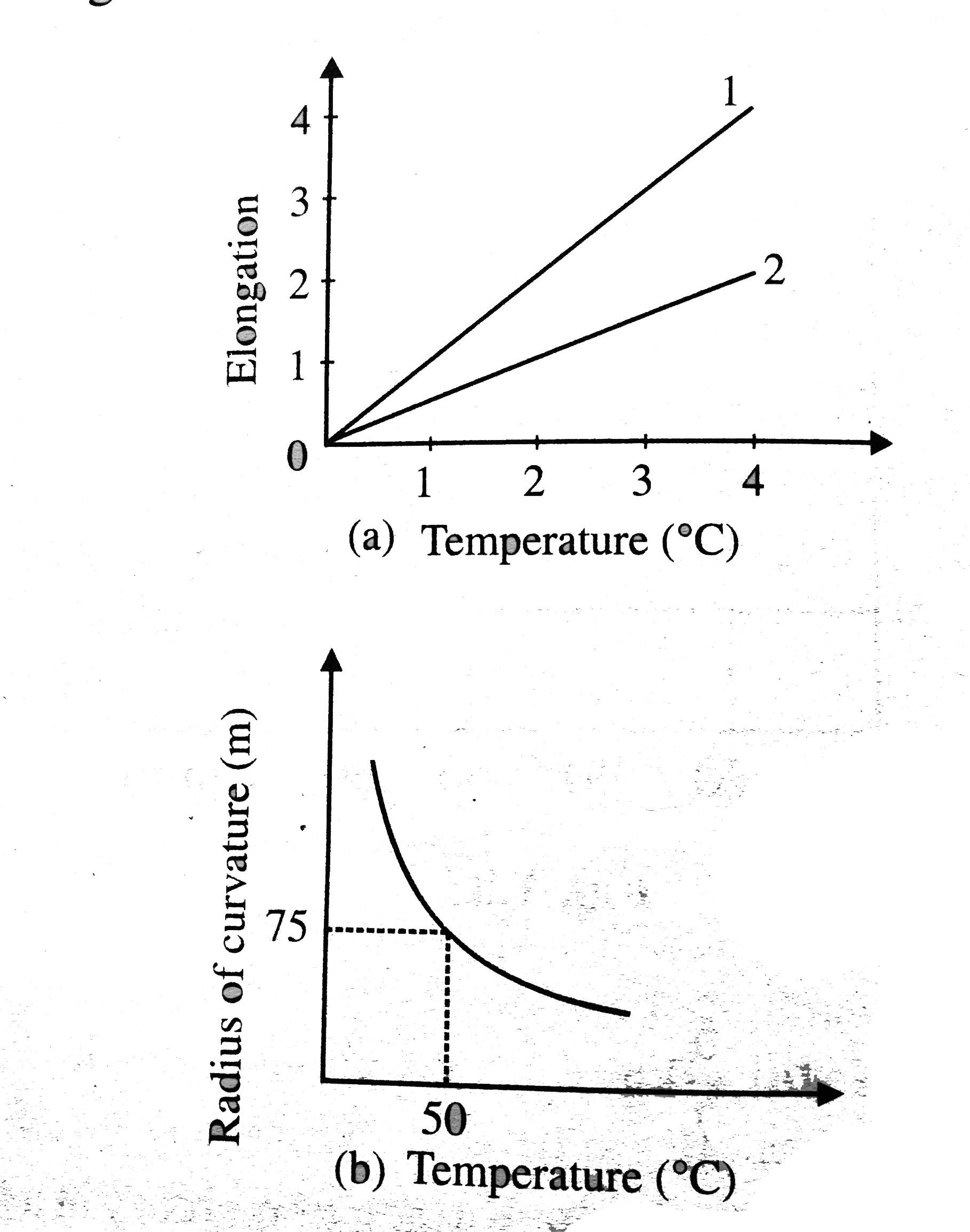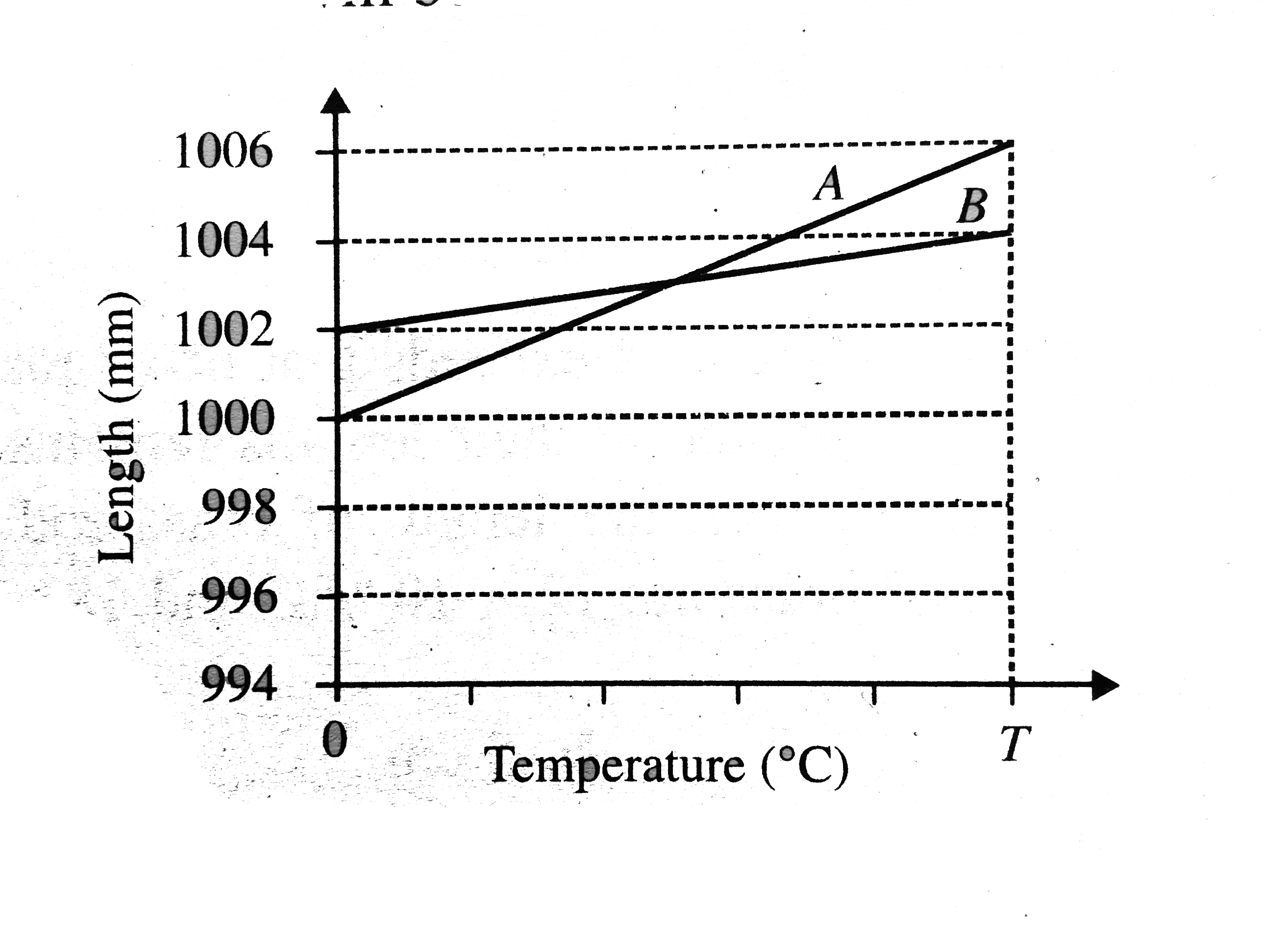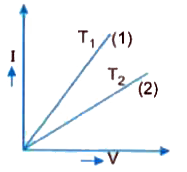Fig. (1) shows the graphs of elongation versus temperature for two different metals. If these metals be employed to form a straight bimetallic strip of thickness 6cm and heated it bends in the form of an arc, the radius of curvature changing with temperature approximately as shown in fig(2). The linear expansivities of the two metals are

24×10−6/°Cand12×10−6/°C
20×10−6/°Cand10×10−6/°C
18×10−6/°Cand10−6/°C
16×10−6/°Cand8×10−6/°C
The correct Answer is:D
Topper's Solved these Questions
- THERMAL PROPERTIES OF MATTERBOOK - AAKASH SERIESCHAPTER - THERMAL PROPERTIES OF MATTEREXERCISE - ADDITIONAL PRACTICE EXERCISE (LEVEL - II) PRACTICE SHEET (ADVANCED) Straight Objective Type Questions (Expansion of Liquids :)
6 Videos
- THERMAL PROPERTIES OF MATTERBOOK - AAKASH SERIESCHAPTER - THERMAL PROPERTIES OF MATTEREXERCISE - ADDITIONAL PRACTICE EXERCISE (LEVEL - II) PRACTICE SHEET (ADVANCED) Straight Objective Type Questions (Expansion of Gases & KTG :)
9 Videos
- THERMAL PROPERTIES OF MATTERBOOK - AAKASH SERIESCHAPTER - THERMAL PROPERTIES OF MATTEREXERCISE - ADDITIONAL PRACTICE EXERCISE (LEVEL - II) PRACTICE SHEET (ADVANCED) Straight Objective Type Questions (Thermometry:)
8 Videos
- SYSTEM OF PARTICLES AND ROTATIONAL MOTIONBOOK - AAKASH SERIESCHAPTER - SYSTEM OF PARTICLES AND ROTATIONAL MOTIONEXERCISE - PRACTICE EXERCISE
99 Videos
- THERMODYNAMICSBOOK - AAKASH SERIESCHAPTER - THERMODYNAMICSEXERCISE - EXERCISE - 3
33 Videos
Similar Questions

Figure. Shows the graphs of elongation versus temperature for two different metals. If these metals are employed to form a straight bimetallic strip of thickness 6 cm and heated, it bends in the form of an arc, the radius of cuvature chaging with temperature approximately as shown in the figure. The linear expansivities of the two metals are
View Solution
The variation of length of two metal rods A and B with change in temperature is shown in Fig. the coefficient of linear expansion αA for the metal A and the temperature T will be
View Solution
Knowledge Check

Figure. Shows the graphs of elongation versus temperature for two different metals. If these metals are employed to form a straight bimetallic strip of thickness 6 cm and heated, it bends in the form of an arc, the radius of cuvature chaging with temperature approximately as shown in the figure. The linear expansivities of the two metals areA24×10−6/∘C and 12×10−6/∘CB20×10−6/∘C and 10×10−6/∘CC18×10−6/∘C and 9xx10^(-6)//^@CD16×10−6/∘C and 8×10−6/∘C
The variation of length of two metal rods A and B with change in temperature is shown in Fig. the coefficient of linear expansion αA for the metal A and the temperature T will beAαA=3×10−6/∘C,500∘CBαA=3×10−6/∘C,222.22∘CCαA=27×10−6/∘C,500∘CDαA=27×10−6/∘C,222.22∘CBars of two different metals are bolted together , as shown in figure. The distance x does not change with temperature if :-
_E01_015_Q01.png) AlAlB=αAαBBlAlB=αBαAClA2lB2=αAαBDlA2lB2=αBαA
AlAlB=αAαBBlAlB=αBαAClA2lB2=αAαBDlA2lB2=αBαA
A bimetallic strip is formed out of two identical strips one of copper and the other of brass. The temperature of the strip goes up by ΔTand the strip bends to from an arc of radius of curvature R. Then R is.
View SolutionBars of two different metals are bolted together , as shown in figure. The distance x does not change with temperature if :-
_E01_015_Q01.png)
View SolutionA bimetallic strip is formed out of two identical strips one of copper and the other of brass. The coefficients of linear expansion of the strip goes up by ΔTand the strip bends to from an arc of radius of curvature R. Then R is.
View SolutionI-V graph for a given metallic wire at two temperatures T1 and T2 is as shown in Fig. Which of the two temperatures is lower and why?

View SolutionA bimetallic strip is formed out of two identical strips one of copper and the other of brass. The coefficients of linear expansion of the strip goes up by ΔTand the strip bends to from an arc of radius of curvature R. Then R is.
View Solution
